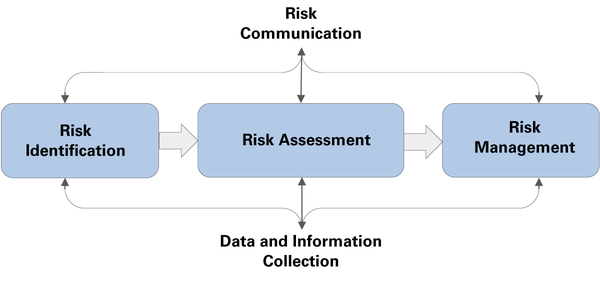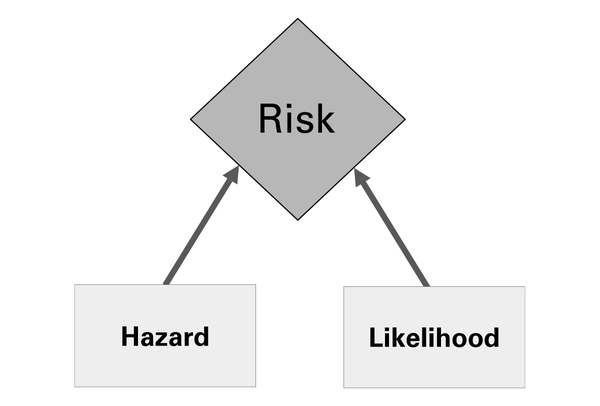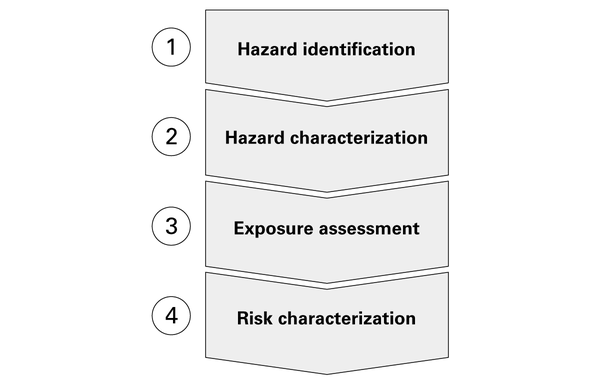Introduction
We frequently encounter a range of environmental, health, and societal risks in our everyday lives. By better understanding the fundamental terms and concepts related to risk, we can be better prepared to respond to these risks in both the near and long terms.
Today, our communities are faced with a number of issues that threaten human health, the environment, and our society more broadly. For example, North Carolina has dealt with a number of complex challenges in recent years related to impacts of hurricanes and coastal flooding, contamination of drinking water supplies, and impacts from the COVID-19 pandemic, among other challenges (Grieger and Cummings 2022) (Figure 2). Dealing with these challenges requires the ability to identify, assess, manage, and communicate risk. Dealing with risk in a proactive way better prepares our communities and decision-makers to grapple with the biggest challenges we face today and in the long term.
This publication outlines and describes core concepts of risk that are used in a variety of environmental, health, and societal circumstances (Figure 3). This information may be particularly helpful for Extension agents, researchers, community members, government officials, and others who wish to identify, assess, manage, and communicate various risks.
Overall, this publication addresses the following questions:
- What is risk?
- How are risks identified and assessed?
- How are risks managed?
- How are risks communicated?
Key risk-related terms are defined and described in the following sections; a list of additional resources is provided at the end of this publication.
What is Risk?
Risk is defined as the possibility of an adverse event or effect occurring. More specifically, risks are often described in terms of hazard and likelihood.
A hazard is a process, substance, event, or activity that can result in an adverse or unwanted consequence. In simple terms, a hazard is described by answering the question “What can go wrong?” The associated likelihood is the probability of the event occurring, or “How likely is that event to happen?” Likelihood is often described as the potential for exposure to the hazard. Risk is therefore the product of both hazard and likelihood (Figure 3).
Uncertainty also needs to be considered when identifying hazard and likelihood. Uncertainty refers to the lack of complete knowledge or information. Uncertainty can be related to limited data or information about the hazard or likelihood, and can also be related to variability in a given system.
As one example, falls are one of the most common accidents at home, particularly for young children or the elderly (CDC 2021). For instance, small toys laying on the floor may lead to individuals tripping and falling over the toys, potentially leading to injury. In this example, the toys laying on the floor serve as the hazard and the probability of an individual tripping over a toy serves as the likelihood of occurrence, resulting in risk. In this case, there is also uncertainty whether an individual may in fact trip over the toy, depending on various factors such as the location of where the toy is on the floor, its size, etc.
Another example of risk is lead contamination in drinking water. Lead is a heavy metal that is known to be harmful to health, especially children, even at low levels. For example, exposure to lead can lead to damage to the nervous system, slowed growth and development, and hearing, speech, or learning disabilities in children (CDC 2022c). Lead is also persistent in the body, meaning it does not degrade or break down easily, and can bioaccumulate, meaning it is not easily eliminated and can accumulate in the body over time. For these reasons, the U.S. Environmental Protection Agency (EPA) has set the maximum contaminant level goal for lead in drinking water at zero (EPA 2023). In this example, lead is the hazard and the probability of a child being exposed to drinking water contaminated with lead is the likelihood of occurrence. To reduce this likelihood, and therefore to reduce risk, the EPA has set a zero-tolerance limit for the occurrence of lead in drinking water (EPA 2023).
Other common examples include risks associated with riding in cars, smoking cigarettes, exposure to infectious diseases, consuming allergens for those with food allergies (such as nuts, milk, dairy, shellfish), and exposure to biological or chemical contaminants in air, water, and food. Many of these examples are complex and have uncertainty when estimating hazard, likelihood, and overall risk.
How are Risks Identified?
The first step to understanding risk is to recognize its existence. In some cases, a new risk emerges and causes risk assessors to describe or characterize it as well as investigate the new risk’s underlying hazard and likelihood. In other words, a new risk may emerge and efforts to understand it are implemented. In other cases, research studies are conducted in advance of or alongside efforts that may lead to the risk’s occurrence to understand and better predict risk. In these cases, researchers are aiming to understand potential risks before any impacts may occur.
For example, in early 2021, public health officials discovered that there was an outbreak of foodborne illness after 21 people from various states reported illness with common symptoms. These individuals were interviewed by public health officials about the foods they consumed. Through these interviews, the officials found that all 21 people had eaten peanut butter the week prior to their illness. These results identified that a new outbreak of Salmonella—a bacterium that results in foodborne illness—had come from a specific brand of peanut butter (CDC 2022d). In this example, the hazard (Salmonella) and exposure to the hazard (i.e., consuming contaminated peanut butter) were identified, resulting in the risk of foodborne illness after it had occurred.
In another example, many studies are currently underway to understand health risks from per- and polyfluoroalkyl substances (PFAS). PFAS represent a vast, complex, and diverse group of manufactured chemicals that are used in many consumer products and household items, including furniture, carpeting, clothing, and food packaging. People may be exposed to PFAS through water, food, soil, and air (NIEHS 2023). Although research on the health risks of PFAS is still in its early stages, studies have found that PFAS are persistent, bioaccumulate in our bodies, and may lead to a number of adverse health effects such as impacts on fertility, immune systems, and metabolism, and may increase chances of some cancers (NIEHS 2023). In this example, the hazard is the individual (or mixtures of) PFAS chemical(s) and the likelihood is probability of being exposed to PFAS, resulting in potential health risks.
In the case of many chemical contaminants, including PFAS, there is a great deal of complexity and uncertainty involved in understanding and estimating risk, as it often takes years or even decades before there is enough scientific evidence to form a complete picture of risk, including estimates of hazard and likelihood. In these cases, it is important to be transparent about the role of uncertainty in risk estimates, particularly when communicating results to a broad audience.
How are Risks Assessed?
Once a particular risk is identified, the next step is to conduct a risk assessment. Risk assessment is a structured process to identify, evaluate, and, if possible, quantify a given risk using available data and information (Aven 2018). The risk assessment process can be defined slightly differently across various areas, although it generally consists of four main steps (Figure 5).
These steps include (1) hazard identification, to determine if exposure to an agent (e.g., a biological or chemical contaminant) has the potential to cause adverse effects; (2) hazard characterization, to understand the relationship between level or dose (e.g., concentration) and severity of effect; (3) exposure assessment, to estimate the dose or concentration of the agent to which various populations may be exposed under different scenarios; and (4) risk characterization, which produces a final risk estimate that combines the previous steps of hazard and exposure assessments. The resulting output may be in the form of quantitative, semi-quantitative, or qualitative estimates of risk if there is significant uncertainty involved (NRC 2009).
Overall, these four stages aim to understand and estimate the effects from exposure to a particular hazard. The risk assessment process is based on available scientific information from laboratory and field-based studies that estimate hazard and likelihood. Risk assessments can also be used to develop a more comprehensive understanding of a given risk, such as the relationship between exposure and the development of adverse health effects, or what concentration or scenario may result in a risk.
As discussed more in the next section, the outcomes of the risk assessment process can be factored into risk management decisions together with other parameters (e.g., risk perception, policy implications, socio-economic circumstances, etc.) to support decision making.
How are Risks Managed?
After a risk is identified and assessed, decisions are made about whether or how to deal with the risk at hand. Risk management refers to actions undertaken to address risk, including steps to prevent, mitigate, or adapt a risk to reach an acceptable level (Aven et al. 2018). Today, we are familiar with many risk management decisions in everyday life, including wearing seatbelts and installing airbags in cars, wearing a helmet while riding a bicycle, labeling foods that contain allergens, and wearing personal protective equipment while handling dangerous chemicals (e.g., pesticide applications) (Figure 6). These activities or decisions aim to reduce risk to health, the environment, or society more broadly.
The field of risk management combines results from risk assessment with many other societal, economic, ethical, and political factors to make decisions. In other words, risk management decisions are not solely based on scientific findings from risk assessment and are often just one of many factors to be considered.
As one example, the U.S. Centers for Disease Control and Prevention (CDC) report that cigarette smoking is the leading cause of preventable death in the United States, with more than 480,000 associated deaths each year (CDC 2022a). To help manage the health risks associated with cigarette smoking, the U.S. federal government has implemented a number of laws including mandatory warning labels on cigarette packages, banning of smoking on domestic flights, and prohibiting tobacco sales to those under 18 years of age (CDC 2022b). In this case, results from risk assessments (alongside many epidemiological studies) are coupled with cultural and economic factors to formulate regulatory decisions to manage health risks of smoking.
Another example that involves more complexity and uncertainty relates to risks of genetically modified organisms (GMO), including GMO foods. After analyzing numerous studies, the U.S. Food and Drug Administration (FDA) determined that GMO foods are just as safe for human consumption as non-GMO foods and do not pose a risk to human health (FDA 2022-GMO). While results from risk assessment studies (and conclusions from regulatory agencies, including the FDA) indicate that GMO foods do not pose a risk, some consumers do not fully accept GMO foods and are willing to pay a premium to purchase non-GMO foods (Kuzma 2018). Studies have shown that some consumers have deep concerns about the societal, ethical, and moral implications of genetic modification and want more transparency in the food supply (Kuzma and Grieger 2020). To help manage these concerns related to GMO foods, the U.S. Department of Agriculture (USDA) recently mandated that all foods containing genetically modified ingredients are labeled as bioengineered (USDA 2019). In this case, risk management decisions considered societal values and preferences to enact decisions to improve transparency through food labeling.
To inform risk management decisions, “concern assessments” may be performed to understand how individuals or organizations perceive risk (IRGC 2015). Information on risk perceptions may help risk managers or decision-makers better understand what would be an acceptable limit of risk (e.g., harm to one out of 1 million individuals vs. harm to out of 1,000 individuals) or obtain other information regarding potential concerns that individuals or groups of individuals may have. In some cases, perceptions of what is considered to be an acceptable limit may differ from findings from risk assessment studies in terms of what is considered to be “safe.”
As mentioned, risk management decisions need to factor in perceptions about risk as well as aspects of risk acceptance or tolerance. A number of factors are known to influence risk perceptions and views. For example, perceptions may be shaped by an individual’s degree of familiarity with the risk, whether the risk is viewed as “natural” or “manmade,” if the risk can be reversed, if risks and benefits are distributed fairly, how much people trust institutions and information sources, and what individuals value as part of their worldviews (Fuchs and Gazso 2015) (Figure 7). Differences in risk perception can also be influenced by demographic factors including gender, religious views, and socio-economic status (Cummings et al. 2013).
After risk management decisions are made, monitoring and feedback are needed to measure the progress of the risk management actions or decisions in place. Monitoring programs can help collect data and information that can be fed back to risk managers or decision-makers to update or revise actions or decisions as needed. This may be in the form of monitoring programs that target, for example, specific health or environmental impact data through sensors or data collection. Overall, the implementation of monitoring and feedback allows risk management decisions to be updated based on the needs of the risk managers or decision-makers within context-specific conditions.
How are Risks Communicated?
One purpose of risk communication is to share relevant risk information so that individuals or groups of individuals can make informed decisions (Aven and Renn 2010). Other related goals of communicating risk are to improve general understanding of a risk among different audiences, disclose risk-related information, improve acceptance of risk management decisions, improve transparency and build trust, educate stakeholders, and encourage certain behavioral changes (Renn and Levine 1991).
Risk communication most often occurs through strategic messaging to inform people who may be vulnerable to certain risks (e.g., the risk of rip currents to beach goers) (Figure 8). Other forms of risk communication can include museum exhibits, conference presentations, panel discussions, pamphlets and public service announcements, as well as more interactive efforts such as focus groups or roundtable discussions.
Some have suggested that when communicating risk information related to an environmental or human health issue, it may be particularly helpful to (1) explain fundamental concepts of hazard and likelihood, including the meaning of probabilities; (2) short-term vs. long-term effects; and (3) acknowledge differences of risk perceptions between different individuals and groups of individuals (Aven and Renn 2010). It is also important to tailor risk communication to the audience and consider their primary motivations, concerns, values, and perspectives.
Good risk communication should provide clear and direct information to empower people to make decisions about the risks they face and the options to reduce them, and should also transparently identify levels of uncertainty. Risk communication should also be inclusive, specific, relatable, and respectful, and seek to understand the audience’s perspectives, understanding, and challenges as they confront the risk(s). Thus, the best risk communication efforts should also strive for iterative, two-way flows of information that may be fed into risk identification, assessment, and management practices.
Summary
We frequently encounter a range of environmental, health, and societal risks in our everyday lives. By better understanding the fundamental terms and concepts related to risk, we can be better prepared to respond to these risks in both the near and long terms.
This publication aims to respond to this need by outlining and describing core concepts of risk, for use by Extension agents, researchers, government officials, and other stakeholders in North Carolina and beyond.
In summary, risks need to first be identified. Next, risks are assessed through risk assessment processes, typically defined by hazard identification, hazard characterization, exposure assessments, and risk characterization steps. The outcomes of risk assessment are integrated into risk management decision-making, while also considering socio-economic, cultural, economic, political, and other factors.
Throughout risk assessment, risk management, and decision-making steps, risk communication should be conducted so that individuals or groups of individuals can make informed decisions. Ideally, two-way flows of information between experts or risk officials and impacted stakeholders should be fed back into risk identification, assessment, and management practices to improve the risk analysis process.
How Can I Learn More about Risk?
To learn more about risk, the following references may be particularly helpful and informative. Additional resources are included in the references section.
Aven, Terje. 2020. The Science of Risk Analysis: Foundation and Practice. New York, NY: Routledge.
Aven, Terje, and Shital Thekdi. 2022. Risk Science: An Introduction. New York, NY: Routledge.
Environmental Protection Agency (EPA). 2022. Learn about Risk Communication. Last modified July 14, 2022.
Berube, David M., Brenton Faber, Dietram A. Scheufele, Christopher L.Cummings, Grant E. Gardner, Kelly N. Martin, Michael S. Martin, Nicholas M. Temple. 2010. Communicating Risk in the 21st Century: The Case of Nanotechnology. National Nanotechnology Coordination 7 Office, Arlington, VA.
EPA. 2022. Risk Management. Last modified May 31, 2022.
EPA. 2023. Risk Assessment. Last modified February 3, 2023.
Fischhoff, Baruch, and John Kadvany. 2011. Risk: A Very Short Introduction. New York, NY: Oxford University Press.
Renn, Ortwin. 2008. Risk Governance: Coping with Uncertainty in a Complex World. New York, NY: Earthscan.
Cho, Hyunyi., Torsten Reimer, and Katharine A. McComas. 2014. The SAGE Handbook of Risk Communication. Los Angeles, CA: SAGE.
Glossary of Key Terms
Concern assessment—An assessment of the concerns that individuals or groups of individuals have, including their perceptions and views of a given risk
Exposure—being exposed to a substance or agent
Exposure assessment—A step in the risk assessment process to estimate the dose or concentration of an agent to which various populations may be exposed under different scenarios
Hazard—A process, substance, event, or activity that can result in an adverse or unwanted consequence(s)
Hazard identification—An initial step in the risk assessment process to determine if exposure to an agent (e.g., a biological or chemical contaminant) has the potential to cause adverse effects
Hazard characterization—A step in the risk assessment process to understand the relationship between level or dose (e.g., concentration) and severity of effect
Likelihood—The probability of an event occurring
Risk—A function of hazard and likelihood of the hazard occurring
Risk analysis—Processes to assess, manage, and communicate risks
Risk assessment—A structured process to identify, evaluate, and quantify (if possible) a given risk using available data and information
Risk characterization—A step in the risk assessment process that produces a final risk estimate combining the hazard and exposure assessments
Risk communication—An exchange of information between officials or experts and individuals or groups of individuals who face a given risk
Risk management—Activities to handle or manage risk, including steps to prevent, mitigate, or adapt a risk to reach an acceptable level
Uncertainty—A lack of complete knowledge or information
References
Aven, Terje. 2018. “An Emerging New Risk Analysis Science: Foundations and Implications.” Risk Analysis 38 no. 5: 876-888.
Aven, Terje et al. 2018. “Society for Risk Analysis Glossary.”
Aven, Terje, and Ortwin Renn. 2010. Risk Management and Governance: Concepts, Guidelines, and Applications. Berlin, Heidelberg: Springer-Verlag.
Aven, Terje, and Shital Thekdi. 2022. Risk Science: An Introduction. New York, NY: Routledge.
Berube, David M., Brenton Faber, Dietram A. Scheufele, Christopher L.Cummings, Grant E. Gardner, Kelly N. Martin, Michael S. Martin, Nicholas M. Temple. 2010. Communicating Risk in the 21st Century: The Case of Nanotechnology. National Nanotechnology Coordination 7 Office, Arlington, VA.
Centers for Disease Control and Prevention (CDC). “Facts About Falls.” Last reviewed August 6, 2021.
CDC. 2022a. “Smoking and Cigarettes: Diseases and Death.” Last reviewed July 29, 2022.
CDC. 2022b. “Smoking & Tobacco Use: Legislation.” Last reviewed January 5, 2022.
CDC. 2022c. “Prevent Children’s Exposure to Lead.” Last reviewed October 24, 2022.
CDC. 2022d. “Salmonella Outbreak Linked to Peanut Butter.” Last reviewed July 27, 2022.
Cummings, Christopher L., David M. Berube, and Mary E. Lavelle. 2013. “Influences of Individual-level Characteristics on Risk Perceptions to Various Classes of Environmental Health and Safety Risks,” Journal of Risk Research 16, no. 10: 1277–1295.
Fischhoff, Baruch, and John Kadvany. 2011. Risk: A Very Short Introduction. New York, NY: Oxford University Press.
Fuchs, Daniela, and André Gazsó. 2015. “Why the Public Perception of Risks is to be Taken Seriously: The Special Case of Nanotechnology.” Nano Trust Dossiers 42: 1–6.
Food and Drug Administration (FDA). 2022. “GMOs and Your Health.”
Environmental Protection Agency (EPA). “Basic Information About Lead in Drinking Water.” Last modified January 27, 2023.
Grieger, Khara, and Christopher L. Cummings. 2022. “Informing Environmental Health and Risk Priorities through Local Outreach and Extension.” Environment Systems & Decisions.
International Risk Governance Council (IRGC). 2015. Introduction to the IRGC Risk Governance Framework. Lausanne, Switzerland.
Kuzma, Jennifer. 2018. “Regulating Gene-Edited Crops.” Issues in Science and Technology 1.
Kuzma, Jennifer, and Khara Grieger. 2020. “Community-Led Governance for Gene-Edited Crops.” Science 370 no. 6519: 916-918.
National Research Council. 2009. Science and Decisions: Advancing Risk Assessment. Washington DC., National Academies Press.
National Institute of Environmental Health Sciences (NIEHS) “Perfluoroalkyl and Polyfluoroalkyl Substances (PFAS).” Last reviewed March 09, 2023.
Renn, Ortwin, and Debra Levine. 1991. “Credibility and trust in risk communication.” In Communicating Risks to the Public. Technology, Risk, and Society, vol. 4, edited by Roger E. Kasperson, Pieter Jan Stallen, 175–217. Springer, Dordrecht.
U.S. Department of Agriculture (USDA). 2019. “National Bioengineered Food Disclosure Standard.”
Publication date: May 22, 2023
AG-945
N.C. Cooperative Extension prohibits discrimination and harassment regardless of age, color, disability, family and marital status, gender identity, national origin, political beliefs, race, religion, sex (including pregnancy), sexual orientation and veteran status.








